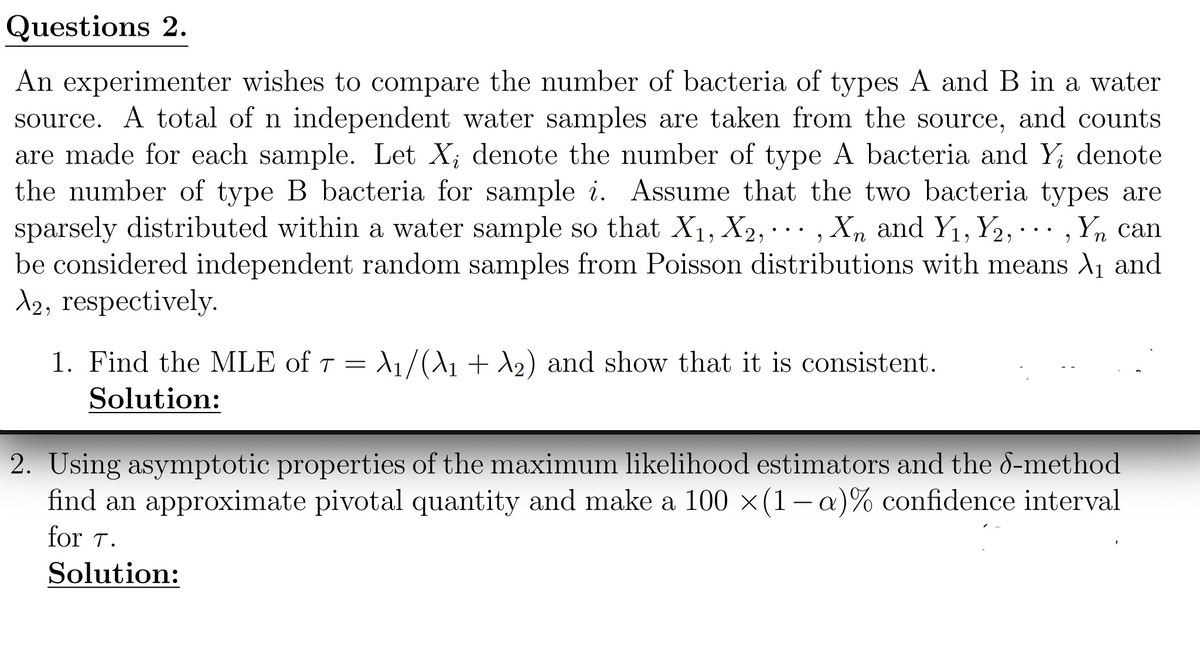Questions 2. An experimenter wishes to compare the number of bacteria of types A and B in a water source. A total of n independent water samples are taken from the source, and counts are made for each sample. Let X; denote the number of type A bacteria and Y; denote the number of type B bacteria for sample i. Assume that the two bacteria types are sparsely distributed within a water sample so that X1, X2,, X and Y₁, Y2,..., Yn can be considered independent random samples from Poisson distributions with means ₁ and λ2, respectively. n 1. Find the MLE of 7 = 1/(\1 + 2) and show that it is consistent. Solution: 2. Using asymptotic properties of the maximum likelihood estimators and the 8-method find an approximate pivotal quantity and make a 100 ×(1-a)% confidence interval for T. Solution:
Questions 2. An experimenter wishes to compare the number of bacteria of types A and B in a water source. A total of n independent water samples are taken from the source, and counts are made for each sample. Let X; denote the number of type A bacteria and Y; denote the number of type B bacteria for sample i. Assume that the two bacteria types are sparsely distributed within a water sample so that X1, X2,, X and Y₁, Y2,..., Yn can be considered independent random samples from Poisson distributions with means ₁ and λ2, respectively. n 1. Find the MLE of 7 = 1/(\1 + 2) and show that it is consistent. Solution: 2. Using asymptotic properties of the maximum likelihood estimators and the 8-method find an approximate pivotal quantity and make a 100 ×(1-a)% confidence interval for T. Solution:
Linear Algebra: A Modern Introduction
4th Edition
ISBN:9781285463247
Author:David Poole
Publisher:David Poole
Chapter2: Systems Of Linear Equations
Section2.4: Applications
Problem 1EQ: 1. Suppose that, in Example 2.27, 400 units of food A, 600 units of B, and 600 units of C are placed...
Question

Transcribed Image Text:Questions 2.
An experimenter wishes to compare the number of bacteria of types A and B in a water
source. A total of n independent water samples are taken from the source, and counts
are made for each sample. Let X; denote the number of type A bacteria and Y; denote
the number of type B bacteria for sample i. Assume that the two bacteria types are
sparsely distributed within a water sample so that X1, X2,, X and Y₁, Y2,..., Yn can
be considered independent random samples from Poisson distributions with means ₁ and
λ2, respectively.
n
1. Find the MLE of 7 = 1/(\1 + 2) and show that it is consistent.
Solution:
2. Using asymptotic properties of the maximum likelihood estimators and the 8-method
find an approximate pivotal quantity and make a 100 ×(1-a)% confidence interval
for T.
Solution:
Expert Solution
This question has been solved!
Explore an expertly crafted, step-by-step solution for a thorough understanding of key concepts.
This is a popular solution!
Trending now
This is a popular solution!
Step by step
Solved in 2 steps

Recommended textbooks for you

Linear Algebra: A Modern Introduction
Algebra
ISBN:
9781285463247
Author:
David Poole
Publisher:
Cengage Learning


Linear Algebra: A Modern Introduction
Algebra
ISBN:
9781285463247
Author:
David Poole
Publisher:
Cengage Learning
